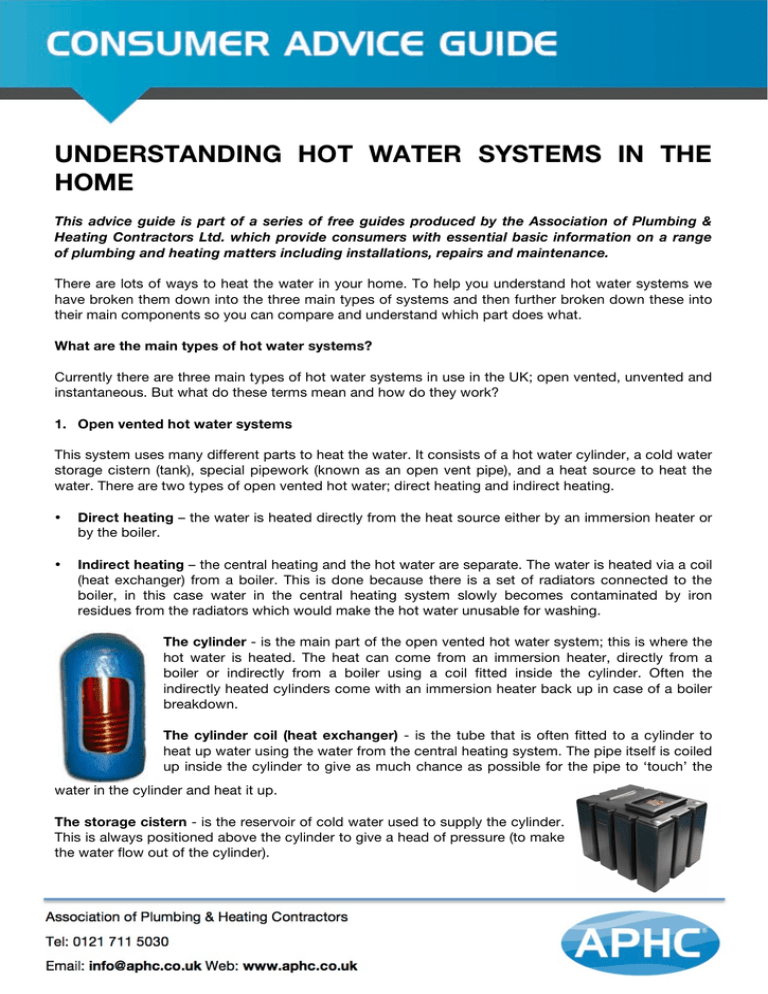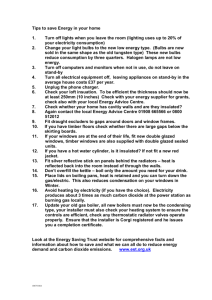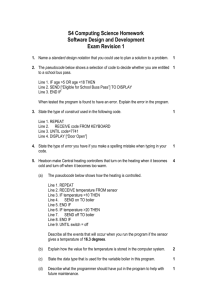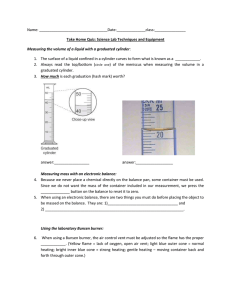understanding hot water systems in the home
advertisement

UNDERSTANDING HOT WATER SYSTEMS IN THE HOME This advice guide is part of a series of free guides produced by the Association of Plumbing & Heating Contractors Ltd. which provide consumers with essential basic information on a range of plumbing and heating matters including installations, repairs and maintenance. There are lots of ways to heat the water in your home. To help you understand hot water systems we have broken them down into the three main types of systems and then further broken down these into their main components so you can compare and understand which part does what. What are the main types of hot water systems? Currently there are three main types of hot water systems in use in the UK; open vented, unvented and instantaneous. But what do these terms mean and how do they work? 1. Open vented hot water systems This system uses many different parts to heat the water. It consists of a hot water cylinder, a cold water storage cistern (tank), special pipework (known as an open vent pipe), and a heat source to heat the water. There are two types of open vented hot water; direct heating and indirect heating. • Direct heating – the water is heated directly from the heat source either by an immersion heater or by the boiler. • Indirect heating – the central heating and the hot water are separate. The water is heated via a coil (heat exchanger) from a boiler. This is done because there is a set of radiators connected to the boiler, in this case water in the central heating system slowly becomes contaminated by iron residues from the radiators which would make the hot water unusable for washing. The cylinder - is the main part of the open vented hot water system; this is where the hot water is heated. The heat can come from an immersion heater, directly from a boiler or indirectly from a boiler using a coil fitted inside the cylinder. Often the indirectly heated cylinders come with an immersion heater back up in case of a boiler breakdown. The cylinder coil (heat exchanger) - is the tube that is often fitted to a cylinder to heat up water using the water from the central heating system. The pipe itself is coiled up inside the cylinder to give as much chance as possible for the pipe to ‘touch’ the water in the cylinder and heat it up. The storage cistern - is the reservoir of cold water used to supply the cylinder. This is always positioned above the cylinder to give a head of pressure (to make the water flow out of the cylinder). The open vent pipe - is the main safety setup for an open vented hot water system. It helps the system cope with the expansion of water in the system. The open vent pipe should end in the storage cistern allowing for the control of expansion of the hot water in the system. How does it all work together? The two diagrams below show the general layout of open vented hot water systems: Unvented hot water systems These systems are far more complicated, and have many more parts to them but do allow near mains pressure hot water supply. They are designed to do away with the storage cistern and operate at a much higher pressure than the open vented system. Pressure reducing valve -This is placed on the incoming cold water main pipe to the hot water system to reduce the water pressure slightly and keep it at a constant level of pressure. Line strainer - This is placed on the incoming cold water main pipe to filter out any particles that might come from the cold water system, because of the sensitive nature of some of the components (a small piece of grit could cause them to malfunction), the strainer keeps them clear. Expansion vessel - This is used to deal with the expansion of the water in the system as it is heated. As water gets warmer it gets bigger, by up to 4% in volume. The water has to go somewhere, the expansion vessel is designed to store this extra water and stop the parts of the system bursting. Temperature and expansion relief valve - This valve is also part of the ‘sealed’ heating system. It is designed to remove pressure from the system. The tundish - This is connected to the pipe coming from the relief valve. This device is placed in the pipeline to alert you to a fault in the system, as you will be able to see the water flowing out of the safety valve(s). How does it all go together? The diagram below shows the general layout of an unvented hot water system: Instantaneous hot water heating systems This method involves using gas or electricity to heat the water to a useable temperature without the need to store the water. The electric versions use a coiled heating element to heat the water rapidly in a similar way to a kettle or immersion heater. The most common method to heat water is the use of a combination boiler, this type of boiler works by using the circuit that powers the central heating and diverting it to another ‘water to water’ heat exchanger (heat swapping). This part swaps out the heat from the heating water to the hot water parts of your home. The boiler diagram below works by heating the central heating water and pumping it around to the diverter valve. This is then diverted from the central heating circuit to go into the water to the heat exchanger where it passes the heat from the central heating water to the cold water coming into the boiler. Common materials and components The following are materials and components, common to all hot water systems. Copper and plastic pipes Pipes for hot systems can be either copper or plastic, and come in many sizes from 8mm to 35mm in diameter. Programmer / timer - This decides to turn the heating boiler on or off, and controls the flow of heated water to the hot water cylinder or radiators. Cylinder thermostat - This little box sits on the hot water cylinder about 1/3 from the top. It measures when the water in the cylinder is warm enough (depending on what you set it to). As the cylinder cools down it will tell the programmer to turn it back on again. Immersion heater – This heater uses electricity to heat the water; this is the same as an electric kettle but on a much larger scale. Where as a kettle is 300 - 500 watts, an immersion heater is 3000 – 5000 Watts. Do you store or not store? There are two ways of providing hot water to the home: A) one using a hot water cylinder to give a store of hot water. B) using a combination boiler or multipoint water heater to give instant hot water. Before deciding which system is right for you, your plumber needs to know how much water will be used at any one time and for how long. Stored hot water Instantaneous hot water Advantages Can deal with high demand more easily Can be cheaper to run as water is heated only when used Water can be heated by green sources of energy like solar or biomass Hot water is produced very fast from cold Allows the connection of different types of water heating methods Can be cheaper to install than a storage system Emergency backup heat source can be fitted to allow hot water if boiler fails No chance of water growing harmful bacteria Disadvantages Can be more expensive to run as water is heated even when not used Can take much longer to get hot water from cold Can be more expensive to install Greater chance of the water growing harmful bacteria Cannot deal easily with high demand Can be very hard to connect alternate sources of hot water heating methods Water can only be heated by non green sources: gas, oil or electricity If the boiler fails there is no emergency backup heat source In summary Hot water systems provide hot water around the home and are relative straightforward, with the majority of new homes having an unvented hot water system or direct hot water system fed from a combination boiler. About APHC APHC is the trade body for the plumbing and heating industry in England and Wales. APHC members are qualified and professional businesses who are committed to high standards of workmanship and high levels of customer service. Only those plumbing and heating businesses that have passed our quality assurance criteria are accepted as members, giving you the consumer peace of mind. Find A Quality Plumber Visit www.FindAQualityPlumber.co.uk to find a qualified and reliable plumbing and heating contractor local to you. Alternatively contact the Association of Plumbing & Heating Contractors Ltd using the contact details located at the footer of this page. Like us on Facebook and keep up-to-date with consumer related plumbing and heating news. www.facebook.com/FindAQualityPlumber Please note that this information is meant as a starting point only. Whilst all reasonable efforts have been made, APHC Ltd. makes no warranties that the information is accurate and up-to-date and will not be responsible for any errors or omissions in the information nor any consequences of any errors or omissions.




